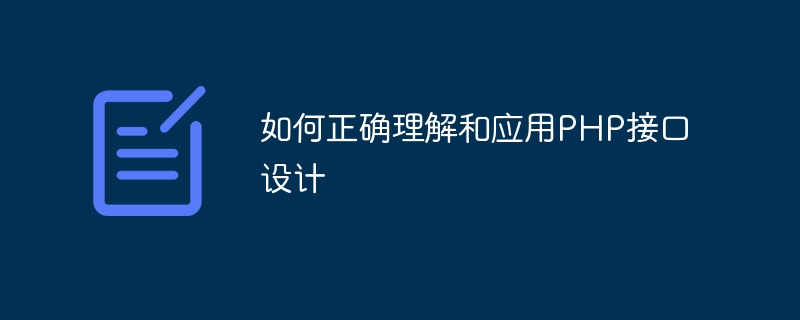

PHP interface design is an important topic, which is of great significance for improving code reusability, reducing coupling and realizing interface-oriented programming. Correct understanding and application of PHP interface design can help us better plan and organize the code structure, and achieve more flexible and maintainable code. This article will discuss how to correctly understand and apply PHP interface design, and provide specific code examples to help readers understand better.
In object-oriented programming, an interface is a specification that defines the methods and properties that a class or object should have, but does not implement them. methods and properties. The interface only defines the declaration of the method, and the specific implementation is completed by the class that implements the interface. Through interfaces, we can achieve decoupling between classes and improve code flexibility and scalability.
In PHP, the interface is defined by the keyword interface. The interface can contain method declarations but not method implementations. Classes use the implements keyword to implement the methods defined in the interface.
The main purpose of interface design is to achieve code reuse and reduce coupling. Through interfaces, we can define a series of method specifications. The class that implements the interface must implement the corresponding methods according to the specifications defined by the interface. This can enable better collaboration between different classes and improve the maintainability and scalability of the code.
In addition, interface design is also conducive to realizing interface-oriented programming. By programming against interfaces rather than specific implementations, we can reduce code dependence on specific implementations and improve code flexibility and testability.
The key to interface design is to reasonably define the interface and abstract the interface into a common specification that can be implemented by multiple classes. The following are some guidelines for correct application of interface design:
Next, we will introduce the application of PHP interface design through a specific example. Suppose we have a zoo scene and need to implement the sounds of various animals. We can achieve this requirement through interface design.
First, we define an AnimalInterface interface:
interface AnimalInterface {
public function makeSound();
}Then, we implement several specific animal classes, such as dogs, cats and birds, and implement ## respectively makeSound method in the #AnimalInterface interface:
class Dog implements AnimalInterface {
public function makeSound() {
echo "Dog: Woof! Woof!";
}
}
class Cat implements AnimalInterface {
public function makeSound() {
echo "Cat: Meow! Meow!";
}
}
class Bird implements AnimalInterface {
public function makeSound() {
echo "Bird: Chirp! Chirp!";
}
}makeSound method to output their respective calls Sound:
$dog = new Dog(); $cat = new Cat(); $bird = new Bird(); $dog->makeSound(); // 输出:Dog: Woof! Woof! $cat->makeSound(); // 输出:Cat: Meow! Meow! $bird->makeSound(); // 输出:Bird: Chirp! Chirp!
AnimalInterface interface, we can realize the sounds of different animal classes and implement the animal Class reusability and extensibility.
The above is the detailed content of How to correctly understand and apply PHP interface design. For more information, please follow other related articles on the PHP Chinese website!
 Ubuntu startup black screen solution
Ubuntu startup black screen solution
 c language else if statement usage
c language else if statement usage
 unicode to Chinese
unicode to Chinese
 Solution to java report that build path entries are empty
Solution to java report that build path entries are empty
 What is the customer service phone number of Meituan Food Delivery?
What is the customer service phone number of Meituan Food Delivery?
 Garbled characters starting with ^quxjg$c
Garbled characters starting with ^quxjg$c
 What is the shortcut key for copying and pasting ctrl?
What is the shortcut key for copying and pasting ctrl?
 How to calculate the factorial of a number in python
How to calculate the factorial of a number in python




